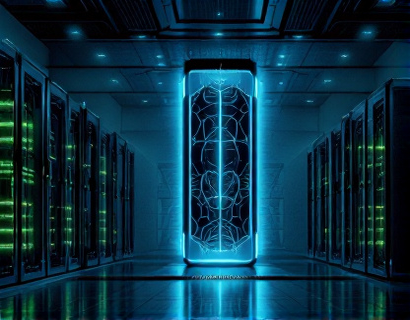Blockchain-Powered Registry Solutions: Enhancing Data Management with Security, Transparency, and Efficiency
In the digital age, the management of data registries has become a critical aspect of various industries, including government, finance, healthcare, and more. Traditional registry management systems often face challenges such as data breaches, lack of transparency, and inefficiencies in data handling. Blockchain technology offers a revolutionary solution to these issues by providing a decentralized, secure, and transparent way to manage data. This article delves into how blockchain-powered registry solutions can transform data management, offering unparalleled security, transparency, and efficiency.
Understanding Blockchain Technology
Before exploring the applications of blockchain in registry management, it's essential to understand the fundamental concepts of blockchain technology. Blockchain is a distributed ledger technology that records transactions across multiple computers in such a way that the registered transactions cannot be altered retroactively. Each block in the chain contains a cryptographic hash of the previous block, a timestamp, and transaction data. This structure ensures that once data is recorded, it is immutable and transparent, as any attempt to alter the data would require consensus from the majority of the network participants.
Security Enhancements in Registry Management
One of the most significant advantages of blockchain in registry management is the enhancement of data security. Traditional systems are often vulnerable to cyber attacks, data breaches, and unauthorized access. Blockchain's decentralized nature and cryptographic algorithms provide a robust defense against these threats. Each transaction is encrypted and linked to the previous transaction, creating a secure chain of data. This makes it extremely difficult for malicious actors to tamper with the data without being detected. Furthermore, the consensus mechanisms used in blockchain ensure that all participants agree on the state of the registry, reducing the risk of fraud and errors.
Transparency and Trust
Transparency is another key benefit of blockchain-powered registry solutions. In traditional systems, data is often stored in centralized databases, which can lead to issues of trust and accountability. With blockchain, all transactions are recorded on a public ledger that is accessible to all participants. This transparency ensures that every change made to the registry is visible and verifiable, fostering trust among stakeholders. For instance, in government registries, citizens can verify the authenticity of records, reducing the potential for corruption and increasing public confidence in government operations.
Efficiency and Streamlining Processes
Blockchain technology not only enhances security and transparency but also improves the efficiency of registry management processes. Traditional registry systems often involve multiple intermediaries, manual data entry, and cumbersome verification processes, leading to delays and increased costs. Blockchain automates many of these processes through smart contracts, which are self-executing contracts with the terms directly written into code. Smart contracts can automate tasks such as data validation, consent management, and record updates, reducing the need for manual intervention and speeding up operations. This automation leads to faster processing times, lower operational costs, and a more streamlined workflow.
Case Studies and Real-World Applications
Several industries have already begun to adopt blockchain-powered registry solutions, demonstrating their practical benefits. In the healthcare sector, blockchain can ensure the secure and private sharing of patient records among different healthcare providers. This not only improves patient care by providing a comprehensive view of medical history but also enhances data security and compliance with regulations such as HIPAA. In the property sector, blockchain can streamline land registry processes, reducing the time and cost associated with property transactions. By creating an immutable and transparent record of property ownership, blockchain minimizes disputes and fraud.
In the financial industry, blockchain-based registry solutions can revolutionize the way securities and assets are traded and managed. For example, blockchain can facilitate the creation and trading of digital securities, reducing the need for intermediaries and lowering transaction costs. This not only increases efficiency but also enhances the transparency and security of financial transactions. In the supply chain industry, blockchain can provide end-to-end visibility of product movement, ensuring authenticity and compliance with regulations. This is particularly valuable in industries such as pharmaceuticals and luxury goods, where counterfeit products are a significant concern.
Challenges and Considerations
While the benefits of blockchain-powered registry solutions are clear, there are also challenges and considerations that organizations must address. One of the primary challenges is the scalability of blockchain networks. Current blockchain technologies, particularly public blockchains, can face performance issues when handling a large volume of transactions. However, advancements in blockchain technology, such as sharding and layer 2 solutions, are addressing these scalability concerns. Another consideration is the regulatory landscape, as the use of blockchain in registry management may require compliance with various laws and regulations. Organizations must ensure that their blockchain solutions adhere to data protection and privacy laws, such as GDPR in Europe.
Implementing Blockchain in Registry Management
For organizations looking to implement blockchain-powered registry solutions, several steps can be taken to ensure a successful transition. First, it's crucial to conduct a thorough assessment of the current registry management processes to identify areas where blockchain can add the most value. This includes evaluating the types of data to be managed, the stakeholders involved, and the specific security and transparency requirements. Next, selecting the right blockchain platform is essential. Organizations should consider factors such as scalability, interoperability, and the level of customization needed. Popular blockchain platforms for enterprise use include Ethereum, Hyperledger Fabric, and Corda, each with its own strengths and use cases.
Once the platform is selected, the next step is to design the blockchain architecture. This involves defining the structure of the blockchain, the roles of different participants, and the smart contracts that will automate processes. It's important to involve stakeholders from various departments to ensure that the solution meets the needs of all parties. Testing and piloting the solution in a controlled environment can help identify and resolve any issues before a full-scale implementation. Finally, providing training and support to users is crucial for the successful adoption of blockchain technology. Organizations should offer comprehensive training programs to help users understand the new system and leverage its benefits effectively.
Future Trends and Innovations
The future of blockchain in registry management is promising, with ongoing innovations set to further enhance its capabilities. One area of focus is the integration of blockchain with other emerging technologies such as the Internet of Things (IoT) and artificial intelligence (AI). IoT devices can generate and record data on the blockchain, ensuring that sensor readings and device interactions are secure and tamper-proof. AI can be used to analyze blockchain data, providing insights and predictive analytics that can inform decision-making processes. Additionally, the development of private and consortium blockchains is addressing some of the scalability and privacy concerns associated with public blockchains, making them more suitable for enterprise use cases.
Another trend is the increasing adoption of decentralized identity solutions built on blockchain. These solutions allow individuals and organizations to control their digital identities, providing a secure and privacy-preserving way to manage personal data. This is particularly relevant in the context of data protection regulations and the growing concern over data privacy. As more industries recognize the value of decentralized identity, the demand for blockchain-powered registry solutions is likely to grow.
Conclusion
Blockchain-powered registry solutions offer a transformative approach to data management, providing unparalleled security, transparency, and efficiency. By leveraging the inherent properties of blockchain technology, organizations can streamline their registry processes, build trust among stakeholders, and comply with regulatory requirements. While there are challenges to consider, the potential benefits make the adoption of blockchain in registry management a compelling proposition. As the technology continues to evolve, we can expect to see even more innovative applications and wider adoption across various industries.










































